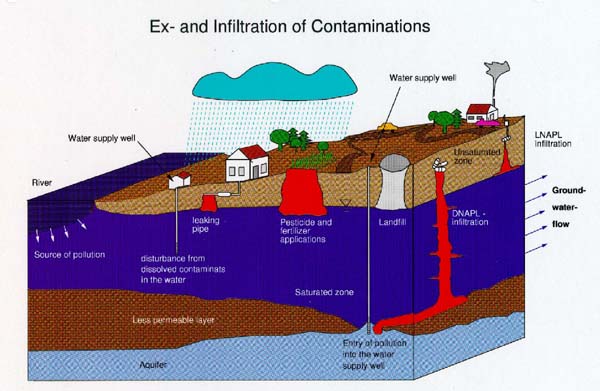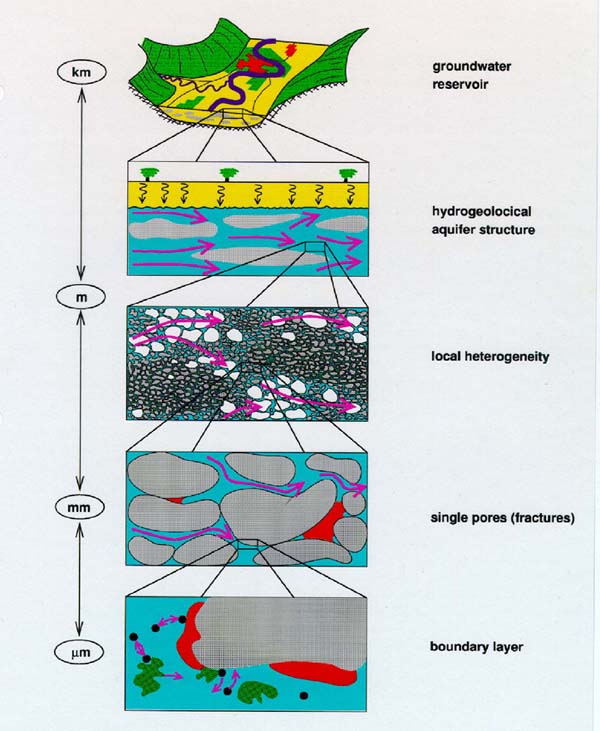INTRODUCTION
Course Goal. The goal of this course is to present the basic concepts underlying the origin, transport and fate of groundwater contaminants in the subsurface along with their relationship to contemporary remediation strategies.
The course is focused exclusively on organic contamination resulting from release of petroleum hydrocarbons (fuels) and chlorinated solvents into the subsurface. The textbook by Wiedemeier et. al., Natural Attenuation of Fuels and Chlorinated Solvents, serves as the primary reference for the course. The term “Natural Attenuation” refers to a particular ground water remediation strategy which calls for carefully monitoring contamination levels in soil and ground water over time to determine if “naturally occurring” processes, such a dilution and contaminant biodegradation, are sufficient to contain and ultimately remediate the contamination site (i.e. without resorting to active remediation methods such as “pump and treat” or “soil vapor extraction”). The focus of the Wiedemeier text book is therefore on hydrologic, chemical and biochemical processes and their relevance to contaminant remediation—rather than on detailing contemporary remediation technologies. This theme fits nicely with our course goal.
The learning strategy for the course is threefold: 1) specific reading assignments from the text are assigned, 2) supplement material provided on the course CD will expand on assigned reading topics (you can think of these as ”lecture notes” because that’s what they are), and 3) written assignments which expand knowledge of individual topics are provided.
The course is presented in module format with multiple “sessions” comprising each module. Module I deals (almost exclusively) with “Abiotic Processes” while Module II focuses on the “Biotic Processes” relevant to the field of bioremediation of organic contaminants. Note that even though the Wiedemeier text deals exclusively with fuels and chlorinated solvents, the basic processes presented can be applied to a broad range of organics (even if they are not considered to be “contaminants”).
We conclude this introduction with some important overview concepts. Figure I-1 below provides a visual overview of important ground water contamination concepts including the behavior of both Light-Non-aqueous-Phase-Liquids (LNAPLS) and Dense-Non-Aqueous-Phase-Liquids (DNAPLS). NAPLS are immiscible with water and therefore retain a separate liquid phase. LNAPLS, such a gasoline, are less dense than water and therefore float on the surface of the water table, while DNAPLS have a density greater than water and thus sink below the water table. Chlorinated solvents are an example of DNAPLS. The properties and behavior of both types of NAPLS are of fundamental importance throughout this course.

Figure I-1. Ground water contaminant behavior in the subsurface.
Also please look at Figure I-2 below. This figure identifies a very important concept which relates to virtually every other topic we will cover in the course. The concept is called “scales of observation”. Notice that processes such as biotransformation of organic contaminants occur at the Microscale or “Pore” scale. Notice also that bulk porous media properties (i.e. permeability, porosity, hydraulic conductivity, and dispersivity) can only be defined at the intermediate and larger scales (these properties are not defined at the pore scale). At the field scale, porous media heterogeneities can become significant and dominate flow and transport processes. At a larger scale regional flow system characteristics become significant.

Figure I-2. Scales of observation in porous media and ground water flow systems.
Module I, entitled Abiotic Processes, is organized into seven “sessions”:
- Session I-1. NAPL Properties and Behavior
- Session I-2. NAPL Distribution
- Session I-3. Equilibrium Partitioning
- Session I-4. NAPL Dissolution and Plume Formation
- Session I-5. Mass Transport Processes Affecting Plume Migration
- Session I-6. BIOSCREEN Model
- Session I-7. Summary and Application
The first two sessions describe how contamination released in the NAPL phase enters the subsurface and distributes within the vadose (variably saturated) zone as well as at and below the water table. Sessions I-3 and I-4 discuss processes by which specific organic contaminants partition out of the NAPL phase and into the soil, air and aqueous phases—resulting in the formation of dissolved contaminant plumes. Sessions I-5 and I-6 examine the processes which control the migration and attenuation of contaminant plumes. Session I-7 concludes Module I with a summary of important concepts and their applications to contemporary remediation strategies.
To begin Module I go now to Session I-1 which explains NAPL Properties and Behavior.